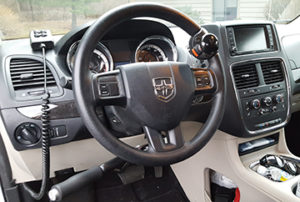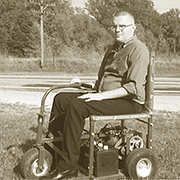By Elizabeth Bokfi
Life can be challenging for amputees, especially soon after surgery. Recovery, pain management, and adaptation—physical and emotional—are all part and parcel of your new life.
As an amputee, transportation is a vital component to returning to a normal life. Having to rely on others for help can sometimes leave you feeling powerless and confined, especially if you were driving independently before amputation surgery. You may have, at some point during your rehabilitation, felt the desire to climb behind the wheel again. To successfully reintegrate into the driving world, you may need to have adaptive equipment installed into your existing motor vehicle or purchase an adapted one.
WHAT YOU NEED TO KNOW
You will need a driver rehabilitation specialist to evaluate your driving abilities before having any specialty equipment installed into your vehicle. Typically, this includes driver performance testing that examines your reaction time, physical functioning, cognitive understanding, and fine motor function. This assessment helps the specialist determine the training and adaptive devices you will need to safely operate your vehicle. For information about these programs and to locate a driver rehabilitation specialist in your area, visit the Association for Driver Rehabilitation Specialists at www.aded.net.
A prescription may be required to have special adaptive equipment installed into your vehicle. Your driver rehabilitation specialist may also be required to add an endorsement on your driver’s license about the equipment installed into your vehicle. Your driver’s permit might have restrictions on the types of vehicles you are permitted to operate.
IN THE DRIVER’S SEAT
Driving aids and vehicle modifications may include hand and/or foot controls, swivel seats, a wheelchair lift, or even a simple seat cushion to facilitate a more comfortable reach. There are many things to consider before having adaptive driving controls installed:
» Am I an upper- or lower-limb amputee? Above or below elbow? Above or below knee? Hemipelvectomy? Hip disarticulation?
» Is my vehicle an automatic or standard shift transmission?
» What is my range of motion? Will I be able to use controls if I’m missing my hand or most of my arm?
» How do I load my wheelchair by myself?
A FEW OPTIONS FOR VEHICLE ADAPTATIONS
Hand Controls
It may be necessary to equip your vehicle with hand controls if you are unable to use your prosthetic limb or remaining leg effectively to operate an accelerator, brake, or clutch pedal. Following are four types of hand control systems that are available:
- PUSH/PULL The driver pushes a grip connected to a rod toward the floor to brake and pulls it to accelerate.
- PUSH/ROCK A handle rests in a vertical position. Braking requires the handle to be pushed forward; acceleration is achieved by easing the handle back.
- RIGHT ANGLE To accelerate, a handle is pushed at a right angle toward your lap. The handle is pushed forward to brake.
- RIGHT HAND This floor-mounted system is operated with the right hand. Pull to accelerate, push to brake.
Foot Controls
- PEDAL GUARDS Following amputation, your brain needs time to adjust to your missing limb. There may be times when you could inadvertently place your foot onto your vehicle’s pedals. Installing a barrier in front of the gas pedal or over the gas and brake pedals prevents you from doing so.
- PEDAL EXTENSIONS These bring foot controls closer to the driver.
Driving Aids
This group of products is helpful when range of motion is an issue. Reaching with your arm is made easier with gear and parking brake extensions and turn signal crossovers.
DRIVER REHABILITATION
Chad Strowmatt, occupational therapist, certified driver rehabilitation specialist, and a post-professional doctoral student, is in the business of getting people mobile. With locations in Houston, Austin, and Dallas, his company, Strowmatt Rehabilitation Services, marries a strong desire for helping people achieve independence and 30-plus years of experience in creating vehicle adaptations that work—even if the idea arrives through unconventional means.
In the case of one of his clients, a quadruple amputee, Strowmatt applied the use of everyday items to create a solution.
“I [came up with the concept] while my wife was mixing items for a cake,” says Strowmatt. “The gas/brake was a small planter and the steering was an actual measuring cup—stainless steel—with a bearing mount system attached to the steering wheel. Both were my ideas to adapt an existing cup concept into [my customer’s] driving controls, designed to mimic a socket design on commonly used prostheses.” For Strowmatt, his one-off measuring cup solution might just be his go-to solution again if he encounters a similar situation in the future.
According to Strowmatt, the timeline from evaluation to installation to up-and-driving varies, but “the actual conversion process time frame can take up to 12 to 18 months for bureaucratic completion and vehicle modification installation into a personal vehicle.” Then there’s the rehabilitation learning curve.
“The first phase is trying to find a physical adaptation that will allow the person to have complete physical control over the device,” says Strowmatt. “As the client utilizes an adaptation, the mental component for learning to drive and integrating the movement into driver performance is always above the shoulders.”
For Laura K., a malignant tumor on her sciatic nerve resulted in a right hemipelvectomy in 2005, following years of living with neurofibromatosis, a genetic disorder that typically produces noncancerous tumors. Her transition to hand controls began in 1996 in a Plymouth Grand Voyager, long before her amputation surgery. She now drives a Dodge Grand Caravan.

“I stand [up] to transfer from my wheelchair to the driver’s seat,” says Laura K. “I have a device [from Adapt Solutions] that lifts my wheelchair into my van—a hoist that works by remote control to lift my manual chair into the space behind the driver’s seat.” In 2013, the lift cost her $3,500; the hand controls were $1,100 from M.C. Mobility.
Is it possible to put a price on freedom and independence? “I sacrificed by not going on vacations for many years, before and after this,” says Laura K. “I don’t buy extras. My last van was 18 years old. I didn’t qualify for any government programs.”
THE WHOLE KIT AND CABOODLE
With wheelchair-accessible vans that have power ramps or lifts, amputees who use wheelchairs and are unable to transfer from the wheelchair to the driver’s seat can remain in their wheelchair and still access the vehicle’s driving controls.Ralph Braun, original founder and creator of BraunAbility (www.braunability.com), recognized the need for improved mobility products long before the catchphrase “wheelchair accessible” came to be. In small town Winamac, Indiana, Braun fashioned the world’s first powered wheelchair in 1962—the coarse beginning of today’s powered scooters.

Living with muscular dystrophy, Braun was determined to remain independent for as long as possible, using his powered scooter to continue his job as quality control inspector at a local factory. When the factory moved, Braun followed. Determined to continue his employment, he commuted to the factory in his self-modified, hand-controlled and hydraulic-fitted, decommissioned postal Jeep. It wasn’t long before others noticed his inventions, and when build requests began, so did Save-A-Step—now BraunAbility, a globally recognized name in vehicle mobility solutions for people with disabilities.
SHOW ME THE MONEY
At just under $28,000 for a used 2011 Grand Caravan Crew with a side-entry wheelchair ramp, it’s important to examine the cost of convenience versus the availability of public transit. A new outfitted vehicle can run upwards of $67,000. Whether you adapt an existing vehicle or buy a new or used one, it pays to do your homework.
If the disability is a result of a workplace accident, you might be entitled to worker’s compensation coverage for adaptive equipment. Private health insurance may also cover a portion of the costs for adaptive devices. If your disability is the result of a vehicular accident, read the fine print of your vehicle’s insurance policy—you may be partially covered after paying the deductible. Nonprofit groups or your local church are also possible sources for assistance.
Most major auto manufacturers offer some form of rebate program. Ford’s Accessibility Program at www.fordupfits.com has a page with step-by-step instructions for claiming up to a $1,000 reimbursement for costs related to the purchase of an adapted vehicle. Chrysler and Toyota offer similar programs, and the amount is deducted from the price of the vehicle after taxes. Some states will waive taxes on adapted vehicles.
The U.S. Department of Veterans Affairs also has a comprehensive information page outlining disability benefits. In some cases, servicemembers may qualify for a one-time disability benefit toward an adapted vehicle.
All in all, with costs considered, and with the absence of public transportation where she lives, Laura K. still cherishes the independence that driving her adapted van provides.
For those who may be timid about driving, she says, “Absolutely go to a rehab driving program. They’ll evaluate you and give you the best options for the best way to get back driving, and to get back your independence.”
For more information, see “Driving Is Still Possible for Most Amputees” in the July/August 2016 issue of Amplitude (pg. 8): www.bit.ly/2THy Phb; or visit the United States Department of Transportation/National Highway Traffic Safety Association at https://bit.ly/2JmcTnU.
FACT: ONLY ONE-FIFTH OF PEOPLE AGE 18 TO 64 WHO HAVE TRAVEL-LIMITING DISABILITIES WORK FULL OR PART TIME.
FACT: PEOPLE WITH DISABILITIES AGE 18 TO 64 TRAVEL AS PASSENGERS FOR A GREATER SHARE OF PERSONAL VEHICLE TRIPS.
FACT: APPROXIMATELY 25.5 MILLION AMERICANS LIVE WITH A DISABILITY THAT IMPEDES TRAVEL OUTSIDE THE HOME.
Statistics Source: United States Department of Transportation, Bureau of Transportation Statistics, “Travel Patterns of Adults with Disabilities.”



